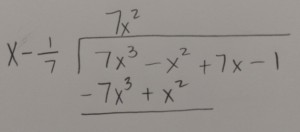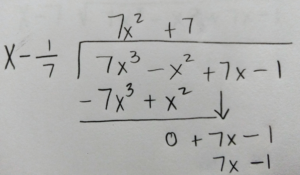Category Archives: MAC1140
Application: Exponential Growth
Graphing Exponential Functions (Base e)
Graphing an Exponential Function (Base Function)
Solving Linear Equations: Two Step Equations
Exponents: Simplify
Example: Rewrite the expression in the form  where p is an algebraic expression.
where p is an algebraic expression.

Solution:
 |
|
 |
 |
 . For this example . For this example  |
 |
Quotient Rule for Exponents  |
 |
 |
Finding Domain: Radical/Root Function (Even Root)
Example: Classify the function as a polynomial function, rational function, or root function, and then find the domain. Write the domain interval notation and set builder notation.

Solution:
Classify the Function
| Polynomial Function
A polynomial function is a function of the form
where n is a non-negative integer {0, 1, 2, 3, 4, …} and the coefficients |
|
| Rational Function
A rational function is a function of the form
where |
|
| Root Function (even index)
A root function is a function of the form
where n is an even positive integer greater than or equal to 2. |
The variable is inside or underneath a radical. The index of the radical is an even number. {2, 4, 6, 8, …} The square root is an even index although the index is not written. |
| Root Function (odd index)
A root function is a function of the form
where n is an odd positive integer greater than or equal to 2. |
The variable is inside or underneath a radical. The index of the radical is an odd number. {3, 5, 7, 9, …} The cube root is an odd index. |
Since the function  has a radical and the index is even. This function is a root function.
has a radical and the index is even. This function is a root function.
Find the Domain of a Root Function (Even Index)
Taking the even root of a negative number results in a complex or imaginary number. Since we are interested in real function values, we would like the expression inside the radical to be non-negative ( zero or positive) The root function is defined for any value of the variable where the expression under the radical is non-negative (zero or positive). Find these values by creating an inequality to solve. The inequality is the expression under the radical greater than or equal to zero.
 |
|
| Solve the inequality. This inequality is a linear inequality and can be solved by isolating the variable on one side. |  |
| Solve by isolating the variable. Start by subtracting 2 on both sides. |         |
| Isolate the variable. Continue by dividing both sides by -1. Be sure to reverse the inequality symbol since you are dividing both sides by a negative. |      |
The function values where  are defined for
are defined for  .
.
In set builder notation, the domain is ![]() .
.
In interval notation, the domain is ( ]
]
Inequalities: Rational Inequalities
Application of Exponential Functions: Doubling Time
Example:
How long does it take for an investment to double if it is invested at 18% compounded continuously?
Solution:
Since this question involve continuous compound interest, we will use the associated formula.

We are given that the interest rate is 18% or 0.18. This tells me that when r=0.18 Since we are looking for the doubling time, A will be 2 times P. I can write that in symbols A=2P.
Substitute these values into the continuous compound formula and solve for the interest rate.
 |
|
| Substitute the values of r and A into the formula |    |
| Solve for t by dividing both sides by P and simplifying |    |
| Solve for t by taking the log of both sides. |   |
    |
|
| Solve for t by dividing both sides by 0.18 and simplifying |    |
| Find the value in the calculator |   |
| Write the answer rounded to two decimal places |   |
It will take 3.85 years to double your money when interest is compounded continuously at 18%.
If you need to write this in years and months, you will need to convert the 0.85 to months. Since there are 12 months in a year, multiply 0.85 by 12 to get 10.2. I will round to the nearest months to get 10.
It will take 3 years and 10 months to double your money when interest is compounded continuously at 18%.
Here is a video that is similar except that you are looking for the investment to triple.
Polynomial Function: Finding Zeros and Write in Factored Form
Problem: Use the rational zeros theorem to find all real zeros of the polynomial function. Use the zeros to factor f over the real numbers.

Since f is a polynomial function with integer coefficients use the rational zeros theorem to find the possible zeros.
The factors of the constant term, 1 are p.

The factors of the leading coefficient, 7 are q.

The possible rational zeros can be found by working out all of the possible combinations of p/q.

Simplifying these combinations give 
To test if any of these potential zeros are actual zeros, evaluate the function at these values.
| x | f(x) | f(x) |
|---|---|---|
| -1 | 7(-1)^3-(-1)^2+7(-1)-1 | -16 |
| -1/7 | 7(-1/7)^3-(-1/7)^2+7(-1/7)-1 | -2.041 |
| 1/7 | 7(1/7)^3-(1/7)^2+7(1/7)-1 | 0 |
| 1 | 7(1)^3-(1)^2+7(1)-1 | 12 |
This can be completed quickly using the ask feature in your calculator.




Since f(1/7) is zero, 1/7 is a zero of the function. Since the function has a zero of  then the function has a factor of
then the function has a factor of 
Use long division or synthetic division to to reduce the polynomial.
 |
|
 |
 |
 |
|
 |
|
 |
|
 |
 |
 |
|
 |
|
 |
Write the function in factored form using the results of the long division.


Factor completely.



 are from the real numbers.
are from the real numbers.
 and
and  are polynomial functions and
are polynomial functions and